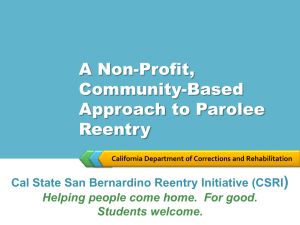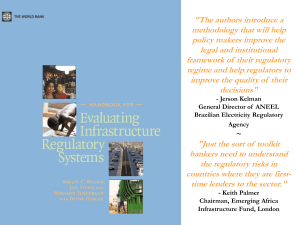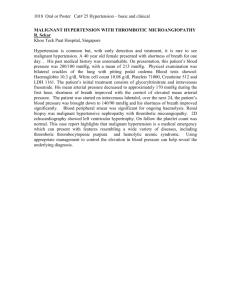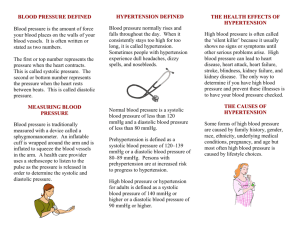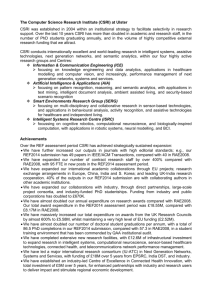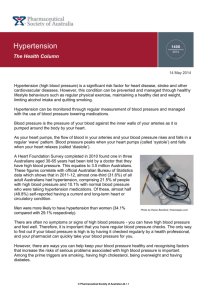Who fails to achieve blood pressure – patients or doctors?
advertisement
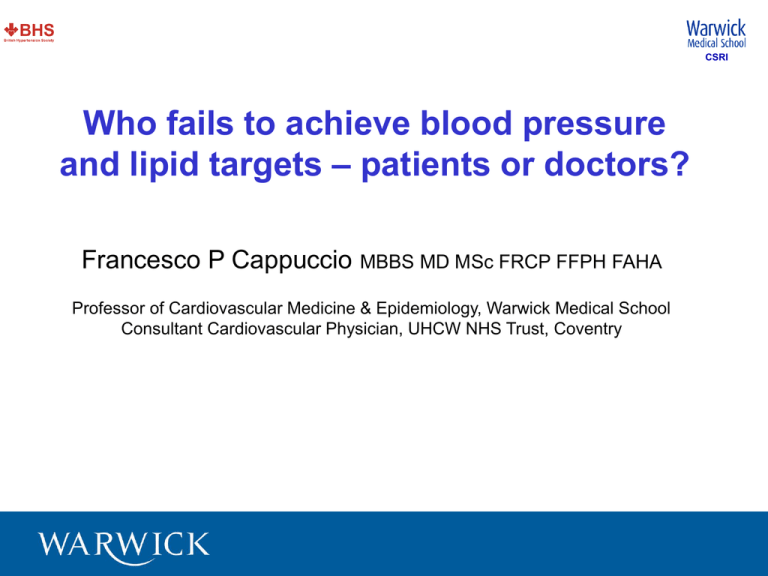
CSRI Who fails to achieve blood pressure and lipid targets – patients or doctors? Francesco P Cappuccio MBBS MD MSc FRCP FFPH FAHA Professor of Cardiovascular Medicine & Epidemiology, Warwick Medical School Consultant Cardiovascular Physician, UHCW NHS Trust, Coventry CV Mortality Risk CSRI Doubles with each 20/10 mm Hg BP increment CV mortality: -fold increase 8 7 6 5 4 3 2 1 0 115/75 135/85 155/95 BP (SBP/DBP mm Hg) 175/105 Lewington S, et al. Lancet 2002; 60: 1903-1913 Long-term antihypertensive treatment reduces CV risk 0 CV event Stroke CSRI CHD −10 −20 −30 20–21 21–28 −40 30–39 −50 Relative risk reduction (%) Risk of CV event with ACEI or CCB relative to placebo CV: cardiovascular CHD: coronary heart disease Neal B, et al. 2000 Uncontrolled BP results in major CV events* CSRI DBP/SBP uncontrolled Major CV events/year* 50 000 DBP uncontrolled SBP uncontrolled 40 000 30 000 20 000 10 000 0 Medicated Unmedicated Total Uncontrolled BP results in major CV events (myocardial infarction [MI], stroke or CV-related death) *Study of the US population Flack JM, et al. 2002 Serum Total Cholesterol and Blood Pressure strong determinants of cardiovascular risk CSRI Erhardt LR et al. Atherosclerosis 2008;196:532-41 Evolution of guidelines on lipid management CSRI Erhardt LR et al. Atherosclerosis 2008;196:532-41 Large numbers of patients are still not reaching cholesterol targets CSRI Erhardt LR et al. Atherosclerosis 2008;196:532-41 One conclusion from an expert panel … CSRI • Harmonise guidelines • Focus on common areas of consensus • Remove boundary between primary and secondary prevention • Focus on level of risk • Help policy makers to understand the different component of CVD • Include professional societies from different specialties in guidelines development and implementation to increase ownership and decrease fragmentation Erhardt LR et al. Atherosclerosis 2008;196:532-41 BHS NICE Guidelines CSRI Potential barriers to BP control in patients with inadequately controlled hypertension in primary care CSRI • Jan-Mar 2004: 110/155 (71%; 27% A/C) patients (50-80 yrs) with last recorded BP >150/90 mmHg (>140/85 mmHg if diabetic) seen in a nurse-led clinic • Standardised measurements plus questionnaire (including lifestyle, compliance and awareness) • 53% still had inadequate BP control • Of those on Rx, 94% reported taking tablets at least 6 days/week • Only 9% knew their target number • Only 39% knew the purpose of BP management and control • Patients with diabetes were more likely to have BP > audit standard (79% vs 42%; p<0.001) Dean SC et al. Fam Pract 2007; 24: 259-62 NSF for CHD progress report: “new drugs and policies of reform and investment have helped to reduce CVD deaths in the UK by more than 23%” CSRI Erhardt LR et al. Atherosclerosis 2008;196:532-41 Q.O.F. Blood pressure (audit) targets Most deprived CSRI Least deprived 90 85 75 70 65 Hypertension Diabetes Stroke & TIA C.H.D. 07 20 06 20 05 20 07 20 06 20 05 20 07 20 06 20 05 20 07 20 06 20 05 60 20 % 80 Data on >8,000 General Practices in England (>97%) Modified from Ashworth M et al. Br Med J 2008;337:on-line November A more aggressive strategy for the treatment of hypertension is needed CSRI Patients with hypertension control (%) 70 63 60 50 46 40 40 40 31 36 30 20 10 0 France Germany Italy Spain UK USA Hypertension control defined as: systolic BP <140 mmHg and diastolic BP <90 mmHg Wang, Y. R. et al. Arch Intern Med 2007;167:141-147. Prevalence, awareness, treatment and control of hypertension* in Europe Awareness** (%) Prevalence** (%) 40 70 35 60 30 50 25 CSRI 40 20 30 15 20 10 5 10 0 0 All Men All Women Treatment** (%) Men Women Control** (%) 60 70 50 60 50 40 40 30 30 20 20 10 10 0 0 All Men Women All Men Women * ESH criteria **adjusted for age, sex and SES Costanzo S et al. J Hypertens 2008; December (in press) The incidence of hypertension is predicted to increase dramatically Population with hypertension (%) 30 CSRI 2000 2025 28 26 24 Overall Men Women The global incidence of hypertension in the adult population is predicted to exceed 29% by the year 2025 Kearney PM, et al. Lancet 2005 Discordance between increase in use of medications and failure to control BP I (1995-1996) II (1999-2000) CSRI III (2005-2007) 100 90 80 70 (%) 60 50 40 30 20 10 0 Hypertension Raised TC Raised LDL-C Diabetes Hypertension: >140/90 mmHg or >130/80 mmHg in diabetics Raised TC: >4.5 mmol/L Raised LDL-C: >2.5 mmol/L EUROASPIRE Surveys - E.S.C. Vienna 2007 Patients with hypertension have additional co-morbidities, making treatment difficult Men Women 0 1 19% CSRI 0 Obesity 1 17% Glucose intolerance 26% 27% Hyperinsulinaemia 4+ 8% Reduced HDL-C 4+ 12% Elevated LDL-C 22% 3 Elevated triglycerides 25% 2 Left Ventricular Hypertrophy 20% 3 24% 2 >50% have two or more comorbidities Kannel WB, 2000 Multiple antihypertensive agents are needed to reach BP goal CSRI Trial (SBP achieved) ASCOT-BPLA (136.9 mmHg) ALLHAT (138 mmHg) IDNT (138 mmHg) RENAAL (141 mmHg) UKPDS (144 mmHg) ABCD (132 mmHg) MDRD (132 mmHg) HOT (138 mmHg) AASK (128 mmHg) 1 2 3 4 Average no. of antihypertensive medications Adapted from Bakris et al. Am J Med 2004;116(5A):30S–8 Dahlöf et al. Lancet 2005;366:895–906 Achieved BP in trials in hypertensive diabetics and number of drugs needed CSRI G Mancia J Hypertens 2002;20:1461-4 Predictors of target failure Nilsson PM, J Hypertension 2005 CSRI 24-hour control of BP is a vital consideration for treatment of hypertension patients CSRI • Treatment guidelines recommend use of antihypertensive agents that provide 24-hour efficacy with once-daily dosing1 • Sustained, 24-hour BP control is important in prevention of CV events1 – the risk of MI and stroke is greater in the morning than at other times of day2 • Control of BP beyond 24-hours is useful in preventing the consequences of an occasional missed dose3 – occasional missing of doses is the most common form of non-compliance in patients with hypertension3 1. ESH/ESC guidelines. J Hypertens 2003;21:1011–1053 2. Elliott WJ. Am J Hypertens 2001;14:291S–295S 3. Burnier M, et al. J Hypertens 2003;21(Suppl 2):S37–S42 Greater 24-hour ambulatory BP control is associated with fewer CV events CSRI Incidence of CV events per 1000 person-years 30 25 20 15 10 5 0 <140 mmHg 140–159 mmHg Clinic systolic BP ≥160 mmHg 24-hour ambulatory SBP <135 mmHg 24-hour ambulatory SBP ≥135 mmHg Adapted from Clement DL, et al. N Engl J Med 2003;348:2407–2415 Still significant variations in the use of drug classes and combination therapy CSRI Cross-national differences in the use of 7 antihypertensive drug classes and combination drug therapy among treated hypertensive patients Wang, Y. R. et al. Arch Intern Med 2007;167:141-147. CSRI Physicians often underestimate their patients’ CV risk CSRI Comparison of actual vs perceived 10-year risk among 80 Swedish GPs Erhardt LR et al. Atherosclerosis 2008;196:532-41 ‘Clinical Inertia’ CSRI Multivariate-Adjusted, Cross-National Differences in the Likelihood of Hypertension Control and Medication Increase for Inadequately Controlled Hypertension* (Cardio-Monitor) Wang, Y. R. et al. Arch Intern Med 2007;167:141-147. 10 steps before you refer for hypertension 1. CSRI Check that the measurement is correct [standardised procedure; validated electronic device] 2. Check compliance, establish concordance [agree with patient and warn of side effects] 3. Encourage weight loss and salt reduction [inform patients (www.bhsoc.org & www.salt.gov.uk)] 4. 5. 6. Stop drugs that raise blood pressure [NSAIDs; OC; ciclosporin] Maximise medication using ACD [BHS-NICE algorithm] Spironolactone [low-dose (12.5mg) to start; watch U+E’s and for postural hypotension] 7. 8. Establish that better control is required [clear, written plan] Ensure that other preventive measures are in place [multi-factorial approach] 9. 10. Are there any investigations that might be useful for the specialist? [TFTs; ECG; Echo-cardio; U/S kidneys; Ur Na, K, Albumin, VMA;] Are you referring to the correct consultant? [Hypertension clinic in local hospital; European Hypertension specialists; ESH Centres of Excellence for Hypertension (BHS website)] McCormack T & Cappuccio FP. Br J Cardiol 2008;15:254-7 What are the barriers to an effective management of hypertension? • Patient – Life-style – Poor compliance (and concordance) – Ineffective drugs – Missed doses – Side effects or Adverse drug reactions – White coat – Need for additional agents – Resistance to treatment – Loss to follow-up – Lack of awareness of targets CSRI • Physician and health-professional – – – – – – Attitudes Training Knowledge and awareness of guidelines Measurement issues Clinical inertia Reluctance to change treatment despite failure to achieve targets – Lack of regular review – Co-morbidity • Organisation – Lack of follow-up – Migration – Failure to refer to specialist centres CSRI Doctor - Try this. If it doesn’t work, come back and I will give you something else Patient - Wouldn’t it be better if you gave me that something else right now?
